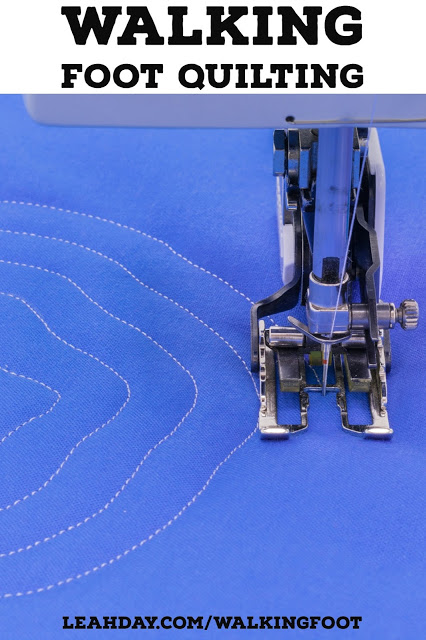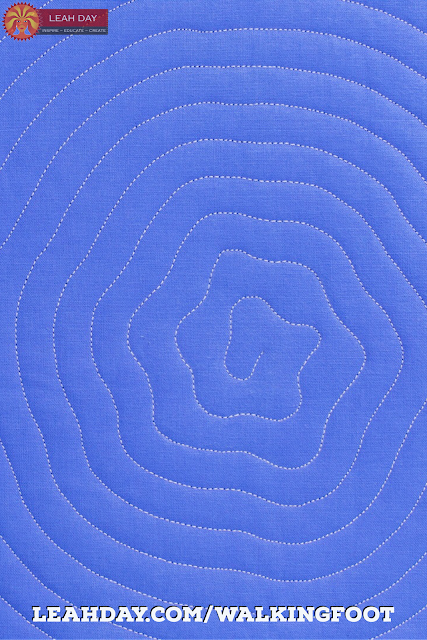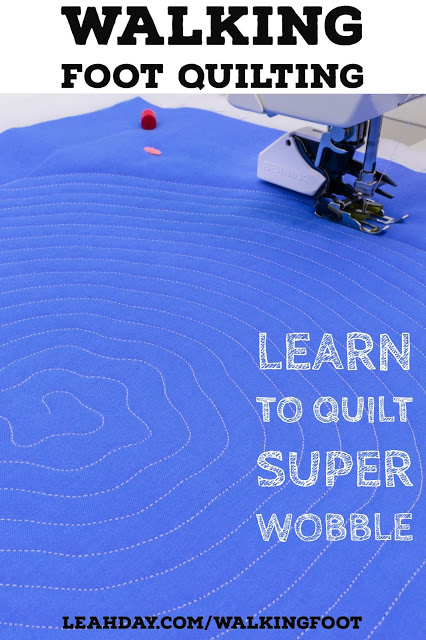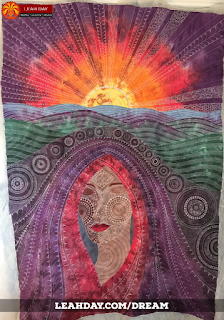Walking Foot Quilting: Let’s Quilt Super Wobble
Click Here to find the Marvelous Mosaic Quilt Pattern in the book Explore Walking Foot Quilting with Leah Day.

Super Wobble is our first spiral design we’ve learned this year. This type of design begins in the center and radiates outward steadily to cover your quilt with a beautiful texture.
To get started, the best way to begin is to mark the starting Super Wobble shape on your quilt. No matter whether you’re quilting a big quilt or a small square, having the starting shaped marked is essential because the start of the spiral is small and your walking foot is really big. Without the lines marked, at least in the beginning it will be hard to tell where you are going.

I used the Ceramic Marking Pencil to mark this design on my fabric. If the fabric was lighter, I’d use the Fine Line Pen instead. I love these two fabric marking pencils and I’ve used them for years because they show up nicely while I need the marks, but erase completely after I’m done quilting.
Click Here to find both marking pens in the Mark Your Quilt Kit!
It may surprise you, but many times when I mark every single line of the design, the entire quilting process goes faster. I think a lot of this has to do with taking the guess work out of the quilt.
When you’re guessing what to do next, or worse have to make frequent decisions on your quilt as to what design to use or how to quilt it, that creates a stopping point.
Every time you stop, even a small stop to pick another design or look at the quilt and decide what direction to quilt into next, that creates a convenient time to walk away from your machine…and who knows when you’ll come back!
I’ve struggled with this myself on the Dream Goddess Quilt. I made the mistake of not deciding the designs to quilt in the sky section. It’s now been over three years unfinished with only a few hours of quilting left to complete it.
I left too many unanswered questions in this section and because of it, I kept stopping and putting it away. Lesson learned! More planning, and even more marking the better.
Spiral in the Right Direction
The key to quilting any spiral is to turn it in the right direction. This is another reason to mark the starting shape because it’s SO easy to get started turning the design counter clockwise.

And if you make this mistake on a big quilt, your arms might not survive to see the end of it!
How you turn any spiral design is very important. The design itself needs to be quilted clockwise so as you quilt out of the center, you will have the least amount of quilt in the arm of the machine.
Tips for Quilting Smooth Curves
This is the first design we’ve tackled this year with curving lines and this is one of those things a walking foot can do, but not without a little manipulation.

Make sure to wear quilting gloves so you can get a grip on the quilt and pivot it smoothly as you stitch the curving lines. Watch out for the deeper curves we quilt in the center of the Super Wobble Spiral – it’s easy to pivot to sharply and end up with a noticeable point within the curving line.
It’s also easy to create whiskering – a soft rippling on the surface which can lead to pleats. If you starch and press your fabric squares before you quilt, that can definitely help to reduce the tendency for the fabric to shift and whisker.
And if this feels really challenging to quilt with a walking foot, you can also free motion quilt this design too! Watch how I quilted Super Wobble into a much smaller square with free motion quilting in this video:
Please understand there’s no right or wrong way to make your Marvelous Mosaic quilt and if you’d like some of the designs to be quilted with walking foot quilting and some free motion quilting, that’s just fine!
To find the quilt pattern for this project and join in the fun, Click Here to find the book Explore Walking Foot Quilting.
Are you looking for all the videos shared so far? Click Here to find them all in one place!
Let’s go quilt,
Leah Day


I am a complete newbie (well, nearly so) at quilting (I love sewing the tops, but never get my own projects done because I don’t know how to actually quilt, other than in the ditch, which is not all I want to do). I am currently working on a small space project (9 placemats) with the idea being to try different things on each one. But I hope to scale up to lap quilt sized projects. (I have an ancient Singer — early 60s, I think — and a new Babylock Accomplish which has a bigger throat than the Singer. I have both a free motion foot and a walking foot.)
My question here is how would you do the turning (with walking foot) on a larger project? I can easily see how this could be a good one to try on one of the placemats, but can’t imagine doing it with a larger quilt.
Also, can you suggest other of your patterns that would be good for a relatively new/beginner quilter for the placemats (as well as larger projects–I have a lap quilt top done ~15 years ready to quilt, and am planning one for a friend as well). I found a cross hatch idea on another site that I will do on one of the placemats, but I want to branch out with other things.
Thanks!
Great question! The #1 key is the direction you turn your quilt. I go into a lot of detail about this in this quilting workshop https://leahday.com/products/mega-star-walking-foot-workshop This workshop is all about walking foot quilting and using different designs together, like what you’ve described wanting to do.
You might also want to check out my book – https://leahday.com/products/explore-walking-foot-quilting-download-ebook This book shows you so many creative ways to quilt with this style of quilting!